I now want to share a bit about what life was like during my WWOOFing experience in central Texas (including lots of photos!). Low Gear Farmstead (based on the farmer’s names, Logan and Geer), is a small operation in its early days. They are very early-stage in their efforts to grow anything, and I don’t think they have a lot of expertise in that area. But Geer’s dad seems always busy planning out the garden and germinating seeds. They have a couple small fields of cover crops (which are crops planted primarily to benefit the soil, rather than for harvesting) and some trees and shrubs they’ve planted near the house. Because the soil is in such rotten shape, they’ve dug small berms around many of the things they’ve planted so that rainwater has time to permeate the soil, rather than just running off, as it typically does.
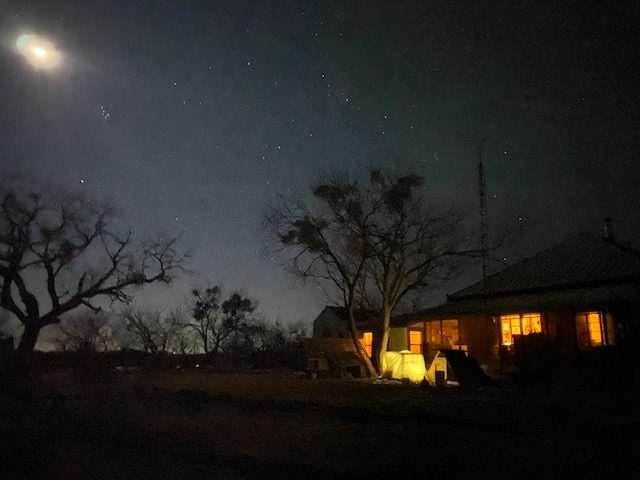
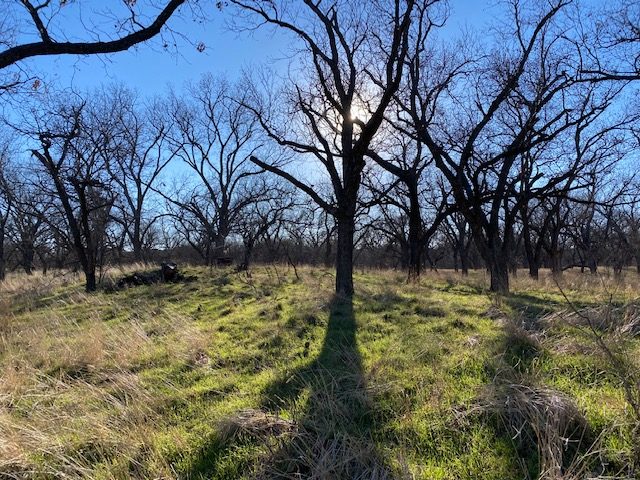
They also have a beautiful pecan orchard by the river. The trees themselves are native pecans. However, since native pecans are apparently so difficult to crack open and use, Logan’s grandfather (or maybe great-grandfather) grafted cultivated pecans onto the native trees. So now the orchard is all cultivated pecans. They’re all over the ground, and cracking pecans is always an activity that’s on the table.
Other than that, their focus is on responsible and sustainable animal husbandry. They have several dozen chickens, 15 goats (5 of which were just born!), a tom turkey, and 4 guinea fowl. The turkey, guinea fowl, and a few chickens live in a coop by the house and are free to wander (though they don’t go too far). The rest of the animals live in two (or more) movable enclosures called paddocks. They use movable electrified net fences to enclose the paddocks, and they rotate the paddocks every couples weeks or even months. The electrification deters predators from getting in (at least ground predators; but they haven’t yet had many issues with hawks or owls).
The land
Low Gear is on 75 acres in the middle of Trump country in Texas. It’s been in Logan’s family for about a century, and it had been just sitting there for a decade or so until Logan decided to go live on it with Geer (they married under a live oak on the property shortly thereafter). The farmhouse was built in the late 1800s and last renovated in the 1950s. Logan and Geer made a couple modifications when they moved in 2 years ago, including replacing the propane stove with a wood-burning one, and taking out the toilets and replacing them with a composting situation (i.e., you poop in a bucket with a seat on it). They also got rid of a lot of furniture, because they believe that sitting on the floor (or cushions on the floor) is healthier than chairs and sofas. That’s just the way they are. I myself slept in a bell tent 100 yards from the house, into which they ran an extension cord (which came very much in handy).
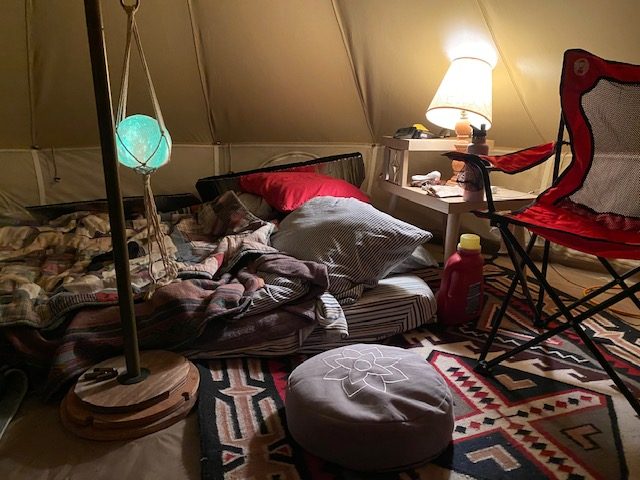
The land itself is not in great shape. I asked Geer about all the rocks strewn across the fields, which you can see all over Texas. Geer explained that it’s a sign of over-grazing. The surface of the rocky soil used to be higher. Then cattle came and ate all the grass and plants (whose roots hold soil intact). With the plants gone, the topsoil was easily erosed by the wind, which is partly why Texas is so dusty. As the land is eroded away, the rocks are left as a troubling reminder of damage done.

Along one border is a beautiful portion of the San Saba river running along one border of their land. The pecans grow near there, as they like water, and tree roots can go very deep. Along their other borders live non-friendly neighbors.

One guy, John Hillman (who goes by “Gator,” for some reason) apparently owns huge swaths of land and mineral rights in west Texas and several ostentatious houses. He also owns the land they need to drive through to access the main road. Last year, he put up some Trump signs. Because Logan and Geer were worried about scaring their Hipcampers (folks mostly from east Texas who come to camp on their land), they put up a big Biden sign on their property. Hillman responded by adding more signs and being a jerk. At some point, Hillman hired someone to spray herbicide on his land from a plane, and the sprayer blanketed portions of Low Gear, their house, and even Geer, who was on his porch. They have legal action pending against the sprayer.

Another neighbor is fighting them about land. This neighbor had been using a corner of Logan’s property for grazing her cattle for a couple decades. When Logan and Geer moved in and saw the damage to the land, they decided to assert their ownership. They got a lawyer and sent a couple letters, including a cease and desist. The neighbor seems to believe it’s her land, either outright or through some sort of squatter’s rights they have in Texas. She has no legal leg to stand on, but she refuses to accept reality. Geer and I spent a couple days putting up an electrified fence on that border (which they’d paid a surveying company to clearly mark, based on the legal records) to keep the neighbor’s cattle from coming onto that land. Geer and I agreed that we hate the idea of fences, but it’s important to do what we can to steward the land. When we were finishing up with the fence, the neighbor showed up and got into a heated conversation with Geer. All he had to do was simply ask her to provide any evidence of her claim to the land. She hemmed and hawed and claimed she had proof but didn’t need to show it to him, but no evidence materialized. Pretty unfortunate that it’s come to this, but it seems to me that this person is just having trouble accepting that the neighborhood is changing. It’s a story as old as time, really.
The dogs
They own two dogs, Coombes and Bjorn. Coombes is likely a beagle/corgi mix, and he is incredibly sweet, attention seeking, and food demanding. He took a shining to me early on, and I took a shining to him. Bjorn was also a sweetheart, but a very different energy. For their own safety, we would sometimes leash the two of them together, and Bjorn would inevitably end up dragging Coombes around. Bjorn is more of a silly “let’s go run around and play” dog, while Coombes is more of a “pet me and let me occasionally follow a scent” dog.

Bjorn being goofy 
Coombes being cuddly 
Pups being lazy
The chickens
One of my favorite activities was the simple task of checking for eggs. I did it several times a day, even though I could’ve easily just checked once at the end of the day. But it just felt like the chickens were leaving me presents, and I loved it! They also have 4 or 5 roosters, whose primary purpose seems simply to involve crowing loudly. Although supposedly having roosters around also helps keep the chickens on good behavior.
They have two movable structures for the chickens: one for nesting (with cute little boxes with hay) and one for sleeping. We’d feed them every morning with a very nutritious-seeming mix of seeds and nutrients, soaked in water, and seasoned with garlic and other herbs that are generally good for their health. We’d get between 5 and 8 eggs a day, which now that I’m on a much bigger farm, actually seems a bit low.


Roosting at night 
These two live with some goats, separate from the hens 
Hens perched in a nesting box
Other birds
The turkey, Wallace, was a sad and annoying sort. He would gobble loudly anytime he heard any noise (without fail, each time I shut my car door, I’d hear him). Any he’s sad because he’s the only one of his kind, and I’m not sure he knows it. You see, once we moved the paddocked chickens closer to the house, Wallace started spending his entire day pacing back and forth outside the paddock, in full plumage, gobbling regularly to get the hens’ attention. See, Wallace has never seen a turkey hen, and I think he probably is guessing that those cute chicken hens are just his type. The poor guy is there, without fail, every day. Pacing back and forth, hoping to get his chance.

The guinea fowl are also very annoying and have few redeeming qualities besides being generally pretty and eating ticks. They have creepy-looking heads with creepy all-black eyes. Moreover, they squawk and bleat and honk all day. They make a few different sounds, and each one is ear-piercingly loud and mind-numbingly unpleasant. One cute thing about them is that their eggs (which Logan and Geer ordered through the mail) were incubated by a chicken hen; so now all the guinea fowl faithfully follow that chicken everywhere, assuming she’s their mother. But still, screw those guineas.

The goats

I know this is the one you’re all here for. The goats were very cool. Most of them are a breed called a Nigerian dwarf, which have a good food-to-milk production ratio; and because they’re small, some people like them as pets. This makes it easy to get rid of males when they’re born. Plus they tend to be pretty sweet. I learned to milk the goats, which is done once a day.
Only one goat, Molly, is giving milk right now. Another goat, Jill, who is a breed called a La Mancha and is particularly derpy-looking, owing largely to her lack of ears, also gets milked, but only on one side where she has chronic mastitis. The milking helps keep it from getting worse.
The goats all have pretty unique personalities. Some of them are jerks. Some of them want to be petted. Some of them only like you if you have food. No surprises.
I’ll dump some photos here, but if you’d like more baby goat photos or videos, shoot me an email!

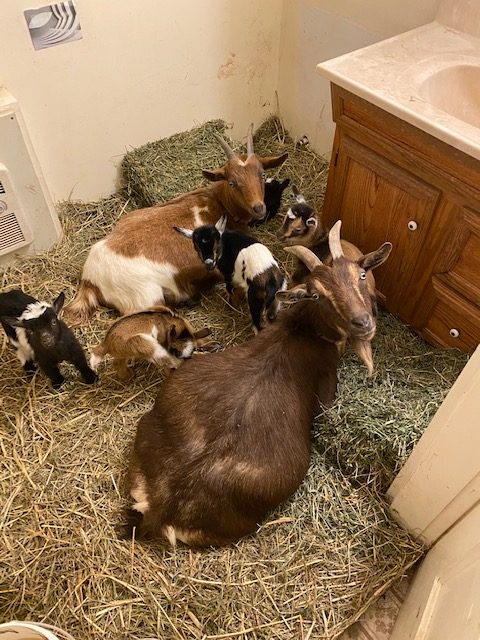
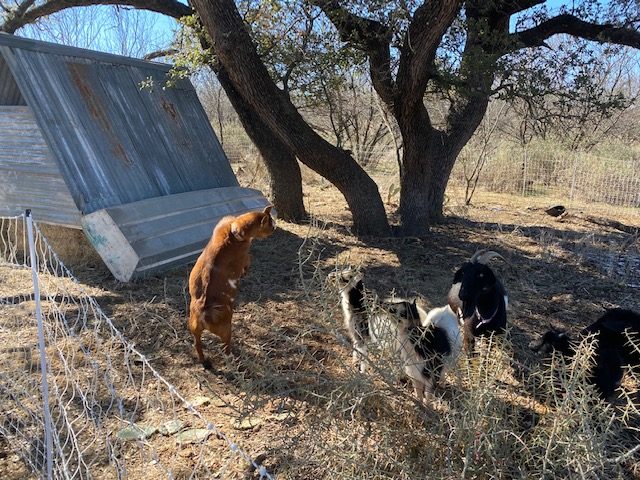
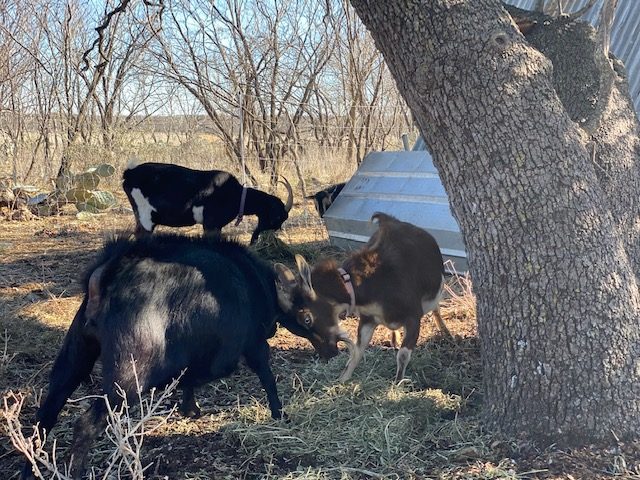
When adding new goats to a paddock, they usually fight to establish status 

Jill
The polar vortex
I chose to start my wander going through the south in order to avoid cold temperatures this year. I guess fate (and the weakened jet stream) had other plans for me. In the worst of it, it got into the single-digits (Fahrenheit). I was sleeping in a permanent tent about 500 feet from the house, but as long as we had power, I was very comfortable sleeping under an electric blanket. Of course, once we lost power, the tent was unlivable. Fortunately, my hosts had a little wood-burning stove, and I set up on a trundle bed among the animals in front of the stove. But boy was it cold, and my body wasn’t ready for it. On the first super cold night, we were outside working, and I got chilled to the bone. I went inside and simply couldn’t get warm. I developed a major headache, chills, etc. I was worried, to be honest. But a night’s sleep under the electric blanket fixed me up, and with the help of layers of thermal clothing, I didn’t have nearly as much trouble the next few days.
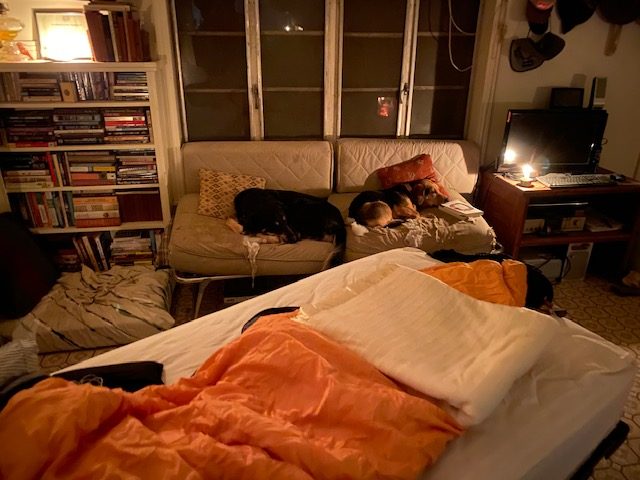
My living room sleeping arrangement 
Logan trying to get warm 
Geer played us some music

Work leading up to the polar vortex was focused on preparing the animals to withstand the cold. We moved the paddocks out of the open fields into more sheltered areas, and then we lined their structures with bales of hay to protect them from the wind. During the cold, we continued monitoring the well-being of the animals, and we also worked on keeping ourselves comfortable, keeping the fire going, carting wood, and trying to keep the well-water system from freezing. But, once we lost power and the heating elements were dead, some pipes froze, and we were out of luck. But Geer, in his infinite ingenuity, managed to keep us as watered as possible, with make-shift fixes to the situation.
As the cold weather started setting in, we noticed that Mitzi, one of the pregnant goats, had a hoof sticking out of her. She was giving birth. Within a couple hours, she’d birthed three kids, and we knew they might be in trouble in the cold. Logan put a tarp and some hay down in the bathroom, and we brought them all inside. The next day, we decided to do the same thing with Brunhilda, who was also pregnant. Sure enough, that night, she birthed 2 healthy kids (and 1 dead kid). For the next few days, the 7 goats lives in the bathroom, fed hay and compost, and occasionally cuddled by us.

Mitzi with her first born 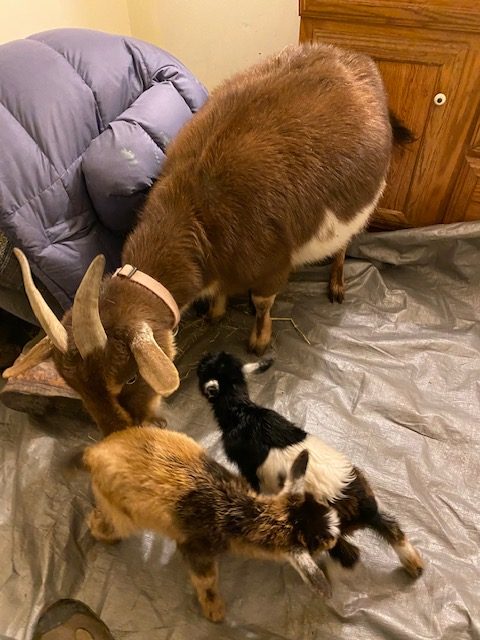
Mitzi in the bathroom 
Happy kiddos
When the weather started to turn, we decided to finally bring the goats back outside in what I can only describe as a parade of cuteness:
Overall, I was fairly well taken care of and fared much better than what so many people experienced elsewhere in Texas!

